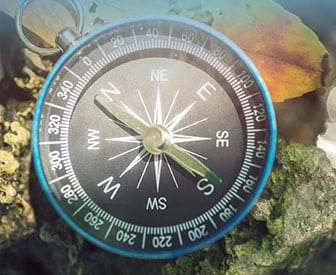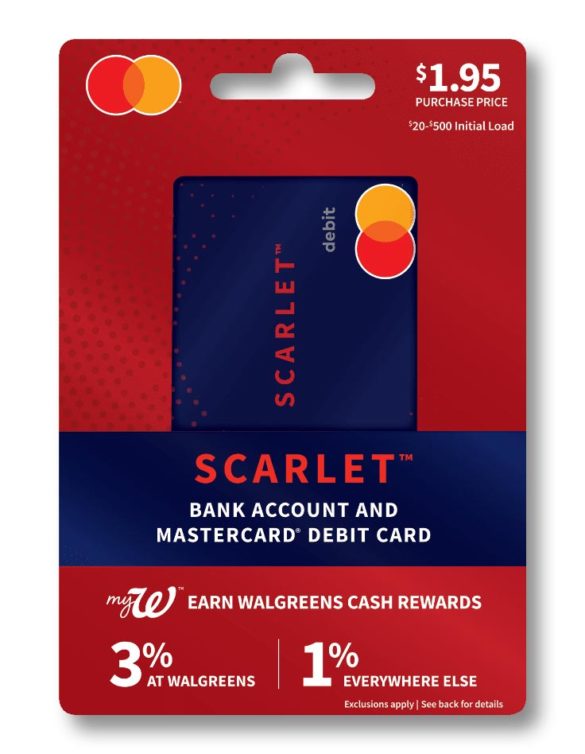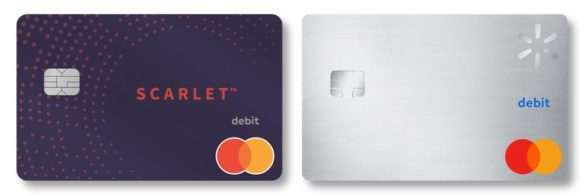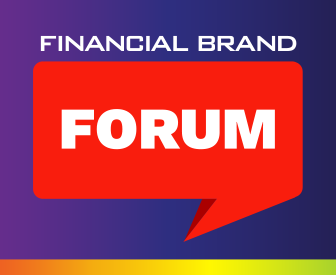Walgreens has introduced a series of financial products built around an enviable pool of prospects — the 75 million members of its myWalgreens loyalty program. The offerings include a bank account and a pair of rewards credit cards, with the company saying this is just the beginning of its foray into financial services.
Walgreens and InComm Payments launched “Scarlet,” a bank account and debit card that can be opened digitally or via a card that can be purchased and activated right off an in-store display rack at one of Walgreen’s 9,000 locations. (This capability isn’t surprising, given that InComm introduced point of sale activation of prepaid cards in 1995, for which it holds a patent.) Shortly before Scarlet kicked off, Walgreens and Synchrony introduced two credit cards, myRewards Credit Card and myWalgreens MasterCard.
A key promotion point around Scarlet is attention to financial wellness, while the credit card offerings promote physical wellness. The program is run by Maria Smith, Vice President of Payments & Financial Services, who came to Walgreens in early 2021 after spending much of her career in payments-related positions at companies including Expedia, Starbucks and The Walt Disney Company.
“Scarlet is just the latest expansion in the Walgreens financial services portfolio, which also includes the Walgreens mobile wallet, remittance services, ATMs, third-party banking services and the recently launched myWalgreens Credit Card.”
— Maria Smith, Walgreens

Send the Right Offers to the Right Consumers
Achieve a better return on your marketing investment. Leverage behavioral data and analytics to target the right customers with the best possible offers.
Read More about Send the Right Offers to the Right Consumers

Are You Ready for a Digital Transformation?
Unlock the potential of your financial institution's digital future with Arriba Advisors. Chart a course for growth, value and superior customer experiences.
Walgreens Taps Banking as a Service for Scarlet Account
Scarlet is built on a MasterCard issued by MetaBank, a leading banking as a service provider that deals with dozens of fintechs and similar programs. The underlying MetaBank account is a noninterest-bearing demand deposit insured by FDIC.
Scarlet accountholders will receive these benefits:
- 3% Walgreens Cash rewards through the myWalgreens program on eligible purchases at Walgreens, Walgreen-owned Duane Reade stores and on Walgreens.com. (Note that newcomers must join myWalgreens in order to open a Scarlet account.)
- 1% Walgreens Cash rewards on eligible purchases wherever Mastercard is accepted.
- Free two-day-early direct deposit access, an increasingly common account feature.
- Free ability to add cash to the account at Walgreens and Duane Reade stores (if done by mobile app). Fees apply to deposits made at point of sale by swipe or those made at other participating merchant locations.
- Free ATM withdrawals via a nationwide network.
- Through Ingo Money, the account permits mobile check capture. (There are two levels of service: a free one promises funds availability with ten days, and “Money In Minutes” service has a minimum fee of $5.)
- Through the Walgreens app, the account has mobile wallet compatibility. It can also handle online and mobile billpay and, in the P2P vein, the ability to send money to other Scarlet account holders. The service also includes the ability to request money from another Scarlet account holder.
- Goal setting software to forecast and manage personal spending. The accounts also have the ability to have segments called “Goals” set up for designated savings targets and subaccounts to permit other family members to have accounts.
Email and text alerts regarding low balances and other account developments.
The availability of basic financial service through the thousands of Walgreens locations can be seen as filling in service gaps in various “branch deserts” around the country. That would apply where consumers still want a physical presence from their provider.
Comparing the Walgreens and Walmart BaaS Offerings
Walgreens’ move comes in the wake of Walmart and Green Dot Bank turning the Walmart MoneyCard prepaid debit card into a full-fledged insured transaction account in June 2021. The MoneyCard also has a rewards system attached to it.
Muted Monetary Marketing:
Curiously, neither the Walgreens nor the Walmart debit cards give the parent brands much exposure. Scarlet is the only brand on the face of that card, and the Walmart Money Card only shows the “*” that used to appear in the middle of Walmart’s name.
Comparing the two programs:
Enrollment. Like the Scarlet card, Walmart MoneyCard accounts can also be opened online or from off-the-rack cards. (Walmart has approximately 4,500 U.S. locations and Green Dot has 90,000 retail distribution locations.)
Cost of the card. Consumers who open the accounts in-store pay a fee, $1.95 for Walgreens, $1 for Walmart. There is no charge for online enrollment in either program.
Monthly Fee. Walgreens’ Scarlet accounts carry a $7.95 monthly fee, which is waived for qualifying levels of recurring direct deposit or a qualifying level of point of sale signature spend transactions. Walmart MoneyCard also offers fee waiver for a qualifying direct deposit; otherwise there is a $5.94 monthly fee.
Overdrafts. While promotions for the Walmart card offer some protection for overdrafts, the Walgreens materials are mostly silent on the matter. The only related mention is that if there are insufficient funds in the Scarlet account, that MetaBank may tap the accountholder’s Goals accounts or one of the sub-accounts. (For Walmart MoneyCard, overdraft protection of up to $200 is available at no charge, provided the consumer has a direct deposit of sufficient size and brings the balance back to $0 within 24 hours of the first transaction that overdrew the account.)
A Curious Omission:
Not mentioning overdraft policy or charges seems odd given the high attention being given the issue in Washington and the competitive policies from neobanks like Chime and some traditional players.
Rewards. Walmart pays up to $75 for cashback earnings by crediting the MoneyCard account annually. There is no ceiling on rewards at Walgreens. On the other hand, Walgreens Cash is not actually real money. As explained in a footnote on the myWalgreens website: “Walgreens Cash rewards are not cash and have no fixed value. Walgreens Cash rewards may not be redeemed for cash and are not transferable to any other individual or entity…”
The company does provide an opportunity to donate the points, which are denominated in dollars, to charities. Subject to rules, Walgreens Cash can be applied to purchases at participating Walgreens stores or online only. When the company’s plans for moving into financial services were announced earlier in 2021, some predicted that part of the reason would be to create extra “stickiness” for Walgreens sales.
No Financial Health Giveaway:
The Walgreens account does not pay interest. The Walmart MoneyCard account doesn’t pay interest either, but provides an affiliated interest-bearing account — 2% APY — for savings purposes.
Read More:
- Neobank Comes Very Close to Being a Bank Without a Charter
- Chime Is Leading the Neobank Pack, But Complaints Are Flooding In
- LendingClub’s Unique Fintech+Bank Model

Looking at the myWalgreens Credit Cards
Of the two credit cards introduced by Walgreens and Synchrony Bank, one is a Walgreens store card, myWalgreens Credit Card. The other is the myWalgreens Mastercard.
Both cards tie into the store’s reward program.
“Most credit cards reward customers for what they buy, but not how they live,” says Walgreens’ Maria Smith. The cards pay Walgreens Cash rewards of up to 10% “for making healthy choices,” according to Smith. This refers to Walgreens branded products. The cards pay 5% on all other eligible brands and on pharmacy purchases. The MasterCard option, offered to consumers with higher credit, can also be used for purchases outside of Walgreens, which may qualify for rewards as well.
Both cards carry no annual fee.









